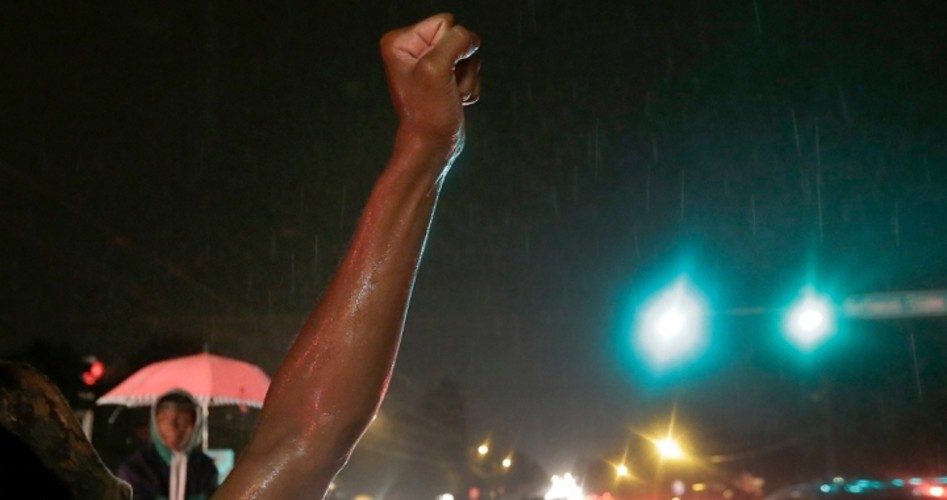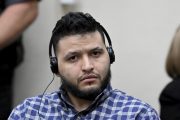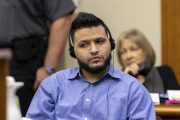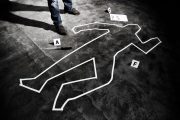
WASHINGTON, D.C. — In what can be termed the “Ferguson Syndrome” for the protests and riots that followed the 2014 shooting of 18-year-old African-American Michael Brown by white Officer Darren Wilson in Ferguson, Missouri, the United States is experiencing a wave of racially motivated protests and riots in cities where white police are acquitted of murder charges in cases involving the shooting of black males.
What we are witnessing in the first year of the Trump administration is a continuation of the racial tensions caused by the Soros-funded Black Lives Matter group that came into being during the end of Obama’s term. They continue to be at the forefront of racially motivated violence. Whenever a white police officer faces criminal murder charges in the shooting of a black male, the anticipation of an acquittal being followed by violent demonstrations prompts police to erect barricades to protect city property and police headquarters.
The 1960s saw riots in black communities that were dominated by a pattern of burning and looting. Today, the street protests following these acquittals of white police shooting African-American males are rapidly turning into the modern model of a race riot, characterized by demonstrations that are peaceful at first, building to confrontations with police, followed by aggressive street demonstrations that culminate in looting and burning.
{modulepos inner_text_ad}
Groups like Black Lives Matter are adopting the aggressive tactics of groups like the hard-left anarchists in the Occupy Movement to advance the narrative that state and local law police are the enemy. They exploit police shootings as the catalyst needed today to rub raw the tensions of racial conflict.
St. Louis Protest Turns Violent
On the evening of Friday, September 15, 2017, hundreds of people rioted under the banner of Black Lives Matter in response to white St. Louis Police Officer Jason Stockley being found not guilty of first-degree murder charges for killing black 24-year-old Anthony Lamar Smith. Smith had been arrested for a suspected drug deal in a fast-food restaurant.
Once again, the incident bore all the characteristics of the “Ferguson Syndrome” — a police shooting, a white police officer acquitted of murder charges, a protest turning violent over the shooting death of a black suspect, and movement activists moving in quickly to portray the victim as an innocent executed by police because he was black and racism still exists.
In a high-speed chase that resulted when Smith sped off, Stockley testified under oath, he saw Smith holding a silver revolver. Stockley further swore at trial that he felt he was in imminent danger.
Prosecutors argued that Stockley planted a gun in Smith’s car after the shooting, noting Stockley’s DNA was on the weapon but Smith’s DNA was not. Dash-cam video from Stockley’s police car showed him saying he was “going to kill this [expletive deleted], don’t you know it.” Less than a minute later, Stockley shot Smith five times, killing him instantly.
In the acquittal, St. Louis Circuit Judge Timothy Wilson wrote, “This court, in conscience, cannot say that the State has proven every element of murder beyond a reasonable doubt or that the State has proven beyond a reasonable doubt that the defendant did not act in self-defense.”
What began as a largely peaceful demonstration turned violent when police blocked protesters on an entrance ramp leading to the city’s convention center.
The Associated Press reported confrontations also erupted when protesters blocked a bus full of officers in riot gear and later damaged a police vehicle with rocks, prompting police to deploy pepper spray.
As night fell, hundreds of demonstrators walked through the streets to the upscale central west end section of the city, where they chanted and marched as people looked on from restaurants and hospital windows lining busy Kingshighway Boulevard.
Tensions escalated when protesters broke a front window and splattered red paint on the home of St. Louis Mayor Lyda Krewson, who had called for calm ahead of the verdict and later said she was appalled by what happened to Smith and “sobered” by the outcome, the AP noted.
Finally, the AP report continued, police in bulletproof vests and helmets closed in and demanded protesters get off the lawn and the street in front of the house, eventually using tear gas to clear the area.
The AP reported that 20 arrests were made by early evening, as protesters were pepper-sprayed in downtown streets. St. Louis police reported 10 officers had suffered injuries by the end of the night, including a broken jaw and a dislocated shoulder. Various journalists reported being threatened by protesters.
On Saturday, September 16, protesters carrying Black Lives Matters signs and chanting “No Justice, No Profits” stormed West Country Mall in St. Louis, forcing a temporary shutdown.
“I can tell you with absolute certainty that there was no plan to murder Anthony Smith during a high-speed vehicle pursuit,” Stockley told the St. Louis Post Dispatch after the acquittal.
“I did not murder Anthony Lamar Smith. I did not plant a gun,” Stockley said, shaking his head.
“Every resisting looks bad. They never look good,” Stockley insisted. “So, what you have to separate are the optics from the facts, and if a person is unwilling to do that, then they’ve already made up their mind and the facts just don’t matter. To those people, there’s nothing that I can do to change their minds.”
The racially motivated riots continued for three more nights in St. Louis, subsiding only when the national news media camera crews packed up and headed for home, confident the news cycle for the protest disruption had peaked.
“Black Lives Expendable”
On August 16, 2016, the Washington Times reported Black Lives Matter was “increasingly awash in cash,” with pledges of more than $100 million from liberal foundations in a six-year pooled-donor campaign that has drawn more than $33 million in grants from top Democratic Party donor George Soros through his Open Society Foundation, as well as grants from the Ford Foundation, Borealis Philanthropy, and John Podesta’s Center for American Progress.
In an article published in August 2016, leftist author Lawrence Ross used a pivotal event in the 1960s civil rights movement to view Black Lives Matters through socialist lenses as modern-day heroes.
“They [Black Lives Matter] faced off against a militarized force of Ferguson police using armored vehicles and rooftop snipers. It was a visual demonstration — as clear as when Birmingham, Ala., Police Chief Bull Connor turned German shepherds and water hoses on African-American schoolchildren in 1963 — of how far a white supremacist police structure would be willing to protect a social hierarchy that made black bodies expendable, their deaths explainable and the protests of the black community discountable,” Ross wrote.
“Ferguson would prove to be the catalyst for Black Lives Matter moving from being a #hashtag movement to a tangible one in the streets of America,” Ross continued. “And as it has matured, the potential for it to become the most powerful mass movement for racial justice in the 21st century is real.”
Writing in The Nation on February 9, 2017, journalist Nathalie Baptiste argued that the rise of Black Lives Matter proves that the hope of a “post-racial” America symbolized by Barack Obama’s election was ephemeral, “a phantasm of campaign rhetoric and political punditry.”
Baptiste argues that white police shooting and killing African-Americans with impunity proves that America remains a racist nation, despite voting twice to put Obama in the White House.
“Having once hoped that the election of the first black president meant that the tide of race relations in America might begin to turn, many young black Americans were forced to face the reality — by one high-profile police shooting after another — that living in a world in which they’re treated like their white contemporaries remains an impossibility,” Baptiste argues.
For Baptiste, the resistance championed today by Black Lives Matters proves America is the same racist nation it was at the time of the founding, despite periodic hopes that times were changing.
“The persistence of police violence against young black people, and the often-racist backlash that followed Obama’s election, initiated this new generation into a cycle that has characterized America’s fraught racial history: A period of optimism born out of a spectacular political moment — the Emancipation Proclamation; Reconstruction; the civil-rights movement of the 1960s — is then followed by a period of reaction and retrenchment,” Baptiste laments.
Grab for Moral High Ground
In the immediate aftermath of the Ferguson shooting, then Attorney General Eric Holder rushed to Ferguson.
In a statement published on the Department of Justice website on August 22, 2014, Holder made it clear he sided with Black Lives Matter, pre-judging the case as proof of police racism — a judgment Holder made without the benefit of waiting for a jury trial.
“But in my conversations with dozens of people in Ferguson, it was clear that this shooting incident has brought to the surface underlying tensions that have existed for some time; tensions with a history that still simmers in communities across the country,” Holder said. “The national outcry we’ve seen speaks to the sense of mistrust and mutual suspicion that can sometimes take hold in the relationship between law enforcement officers and their constituents.”
In a 2015 radio interview produced by an activist group called “The Party for Socialism and Liberation,” Bill Ayers — the former colleague of Barack Obama who co-founded the domestic terrorist group Weather Underground — acknowledged that Black Lives Matter is a Marxist group with a focus on “state violence against black people.”
The Black Lives Matter platform published on the group’s website affirms Ayers’ conclusion.
The Black Lives Matter platform reads in part:
Together, we demand an end to the wars against Black people. We demand that the government repair the harms that have been done to Black communities in the form of reparations and targeted long-term investments. We also demand a defunding of the systems and institutions that criminalize and cage us. This document articulates our vision of a fundamentally different world.
The attempt by Black Lives Matter to gain the high moral ground is consistent with the hard-left view that President Trump must denounce “white supremacists,” but cannot equally condemn Black Lives Matter violence.
In an interview with the Los Angeles Times published on August 25, 2017, Patrisse Cullors, a co-founder of Black Lives Matter made clear she would not meet with President Trump.
“We wouldn’t as a movement take a seat at the table with Trump, because we wouldn’t have done that with Hitler,” Cullors said. “Trump is literally the epitome of evil, all the evils of this country — be it racism, capitalism, sexism, homophobia.”
Cullors was determined that the only path to deal with President Trump was resistance.
“He has set out some of the most dangerous policies, not just that impacts this country but impacts [sic] the globe,” Cullors continued. “And so for us, the answer is not to sit with him but to resist him and to resist every single policy that he’s implemented that impacts our communities.”
Reading Cullors’ comments, it was clear she demonized President Trump.
“And … if I’m thinking about what I want my children to know in 30, 40, 50 years, I want them to know that I resisted a president at all costs, because this president literally tried to kill our communities, and is killing our communities.”
This is a remarkable statement, given that Trump had people of all races in his employ in 2014 when Ferguson happened, and in 2012 when George Zimmerman killed Trayvon Martin — the precipitating incident around which Black Lives Matter was formed.
Photo: AP Images
This article was originally published by the Law Enforcement Charitable Foundation, Inc., and appears here with permission.



